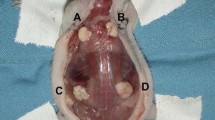Abstract
Micronized cross-linked human acellular dermal matrices (ADMs) contain the extracellular components necessary for cell integration and tissue remodeling, and have high tensile strength and durability. We hypothesized that such material could serve as a scaffold to enhance the survival of adipocytes in grafted fat. Nude mice (n = 15) were randomly assigned to three groups, each receiving different subcutaneous injections into two dorsal paravertebral areas: fat and saline (control), fat and micronized ADM (E1), and fat and diluted micronized ADM (E2). Digital photographs were taken at 2-week intervals, and the grafted fat volumes and weights were examined after 10 weeks. A histological analysis of the grafted fat was performed, and the expression of vascular endothelial growth factor (VEGF) was examined. The grafted fat volumes decreased over time in all groups; however, at 10 weeks, the grafted fat was better preserved in both experimental groups, with significantly greater weights than in the group C (both, p < 0.001). In the experimental groups, there was more regular arrangement of collagen in the graft tissue, whereas relatively thin, disorderly collagen deposition was observed in the control group. In addition, VEGF expression was significantly greater in the experimental groups than in the control group (p < 0.001). These results are the first to show that micronized cross-linked human ADMs are an excellent scaffold for promoting adipocyte survival and may be an option for maintaining or promoting the in vivo survival of grafted fat.






Similar content being viewed by others
References
Temiz G, Sirinoglu H, Yesiloglu N, Filinte D, Kacmaz C. Effects of deferoxamine on fat graft survival. Facial Plast Surg FPS. 2016;32:438–43.
Jung DW, Kim YH, Kim TG, Lee JH, Chung KJ, Lim JO, et al. Improvement of fat transplantation: fat graft with adipose-derived stem cells and oxygen-generating microspheres. Ann Plast Surg. 2015;75:463–70.
Gillis J, Gebremeskel S, Phipps KD, MacNeil LA, Sinal CJ, Johnston B, et al. Effect of N-acetylcysteine on adipose-derived stem cell and autologous fat graft survival in a mouse model. Plast Reconstr Surg. 2015;136:179e–88e.
Baek RM, Park SO, Jeong EC, Oh HS, Kim SW, Minn KW, et al. The effect of botulinum toxin A on fat graft survival. Aesthet Plast Surg. 2012;36:680–6.
Lee JH, Kim HG, Lee WJ. Characterization and tissue incorporation of cross-linked human acellular dermal matrix. Biomaterials. 2015;44:195–205.
Itoi Y, Takatori M, Hyakusoku H, Mizuno H. Comparison of readily available scaffolds for adipose tissue engineering using adipose-derived stem cells. J Plast Reconstr Aesthet Surg JPRAS. 2010;63:858–64.
Lee DW, Lee MC, Roh H, Lee WJ. Multilayered implantation using acellular dermal matrix into nude mice. J Mater Sci Mater Med. 2014;25:2669–76.
Pietramaggiori G, Scherer SS, Mathews JC, Alperovich M, Yang HJ, Neuwalder J, et al. Healing modulation induced by freeze-dried platelet-rich plasma and micronized allogenic dermis in a diabetic wound model. Wound Repair Regen. 2008;16:218–25.
Wise JB, Cabiling D, Yan D, Mirza N, Kirschner RE. Submucosal injection of micronized acellular dermal matrix: analysis of biocompatibility and durability. Plast Reconstr Surg. 2007;120:1156–60.
Kato H, Mineda K, Eto H, Doi K, Kuno S, Kinoshita K, et al. Degeneration, regeneration, and cicatrization after fat grafting: dynamic total tissue remodeling during the first 3 months. Plast Reconstr Surg. 2014;133:303e–13e.
Nishimura T, Hashimoto H, Nakanishi I, Furukawa M. Microvascular angiogenesis and apoptosis in the survival of free fat grafts. The Laryngosc. 2000;110:1333–8.
Acknowledgements
This work was supported by a National Research Foundation of Korea (NRF) Grant funded by the Korea government (MEST; No. 2014051295, WJ Lee).
Author information
Authors and Affiliations
Corresponding author
Ethics declarations
Conflict of interest
No authors have conflicts of interest that could potentially influence the described research.
Ethical statement
All animal protocols used in this study were approved by the Institutional Animal Care and Use Committee of Yonsei University (IACUC No. 2013-0306-2). Additionally, all procedures were approved by our institutional review board (IRB No. 4-20130618).
Rights and permissions
About this article
Cite this article
Park, T.H., Choi, W.Y., Lee, J.H. et al. Micronized Cross-Linked Human Acellular Dermal Matrices: An Effective Scaffold for Collagen Synthesis and Promising Material for Tissue Augmentation. Tissue Eng Regen Med 14, 517–523 (2017). https://doi.org/10.1007/s13770-017-0054-1
Received:
Revised:
Accepted:
Published:
Issue Date:
DOI: https://doi.org/10.1007/s13770-017-0054-1




